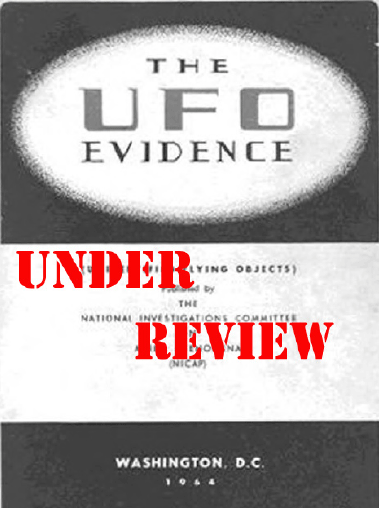
June 30, 1954
This case was given special consideration because it supposedly involved scientists seeing, and recording, UFOs during an eclipse expedition. The chronology de- scribes it this way:
June 30, 1954--Nr. Oslo, Norway. Two silvery disks observed and photographed from eclipse expedition planes. [VIII]1
Section VII gives a description of the film.
Scandinavian eclipse film. Three aircraft carrying scientists, newsmen and other observ- ers were flying near Lifjell, Denmark; on an expedition to film and study a total eclipse of the sun. At 2:17 p.m. two shiny discs were noticed flying past the planes and witnessed by about 50 people on the three planes. John Bjornulf, chief cameraman of the expedition, managed to obtain about 10 seconds (of the approximately 30 second UFO flight) on 16 mm color film. The film was reportedly shown on American television December 26, 1954. [See Section I]2
Section I states their source for this information comes from a story written in the Lon- don Evening News by Robert Chapman on December 21, 1955. This is over a year later but it gives a rather extraordinary account given by an Ernest Graham, were 50 people saw the UFO:
A solar eclipse was in progress, and three planes carrying scientists and technicians on a scientific expedition were flying through the moon’s shadow. About 50 people in the three aircraft saw two “enormous” silvery discs swoop down from some clouds 15 to 20 miles away (estimate based on fact UFOs were in sunlight).
The objects sped along the horizon keeping an exact distance from each other, one slightly behind and above the other, both with for- ward edge tilted down. The observers detected apparent rotation, as the UFOs leveled off and disappeared into the distance after about 30 seconds. The chief cameraman of the expedition, John Bjornulf, managed to expose about 10 seconds of movie film which showed the UFOs. The films, released by Gaumont, a British firm, were shown on American television September 26, 1954. Still photographs of the UFOs have also been printed. Ernest Graham, one of the witnesses, stated that 50 persons afterwards wrote reports on what they had seen.3
The total eclipse had occurred at 1:32 PM4 local time so the film was not during totality but during the partial phases after totality. Additionally, Lifjell is in Norway and not Denmark. The eclipse was not total in Denmark and the scientists would have no need to be flying in an area outside of the eclipse path. Since there is no Blue Book file on the photographs one has to look elsewhere for additional information.
NICAP did not include the photographs but research revealed they are available. Vicente-Juan Ballester Olmos has an excellent copy in his Fotocat report #1: The year in photographs 1954.5 It shows the wing of the aircraft and two white lines that appeared to be streaking points of light or disk shaped objects seen on edge.
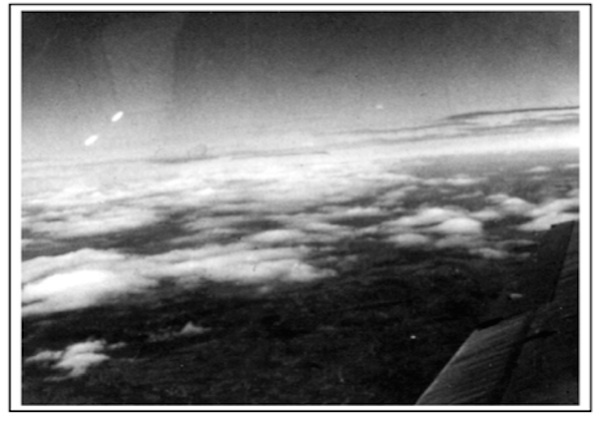
---
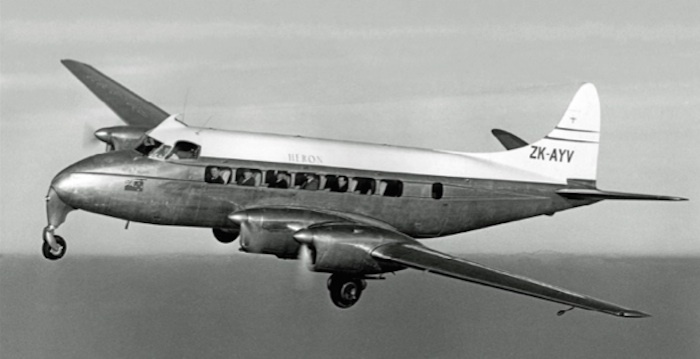
Other details reveal that the film was shot through the windows of a Heron aircraft6 at very high altitude. To prevent window glare for the photographers, the panes had been removed on some of the windows.
News Accounts
The account of the film was a news story in several newspapers in early July of 1954.7 It told a slightly different story than what appears in NICAP’s document. Instead of these saucers being seen and then filmed, the photographer did not see the objects at the time. He only saw them after he watched the film. The newspaper also mentions that an unnamed photographic expert felt they were reflections resulting from filming through the laminated glass windows. Bjornulf also seemed to think they were some sort of mirage or reflection.
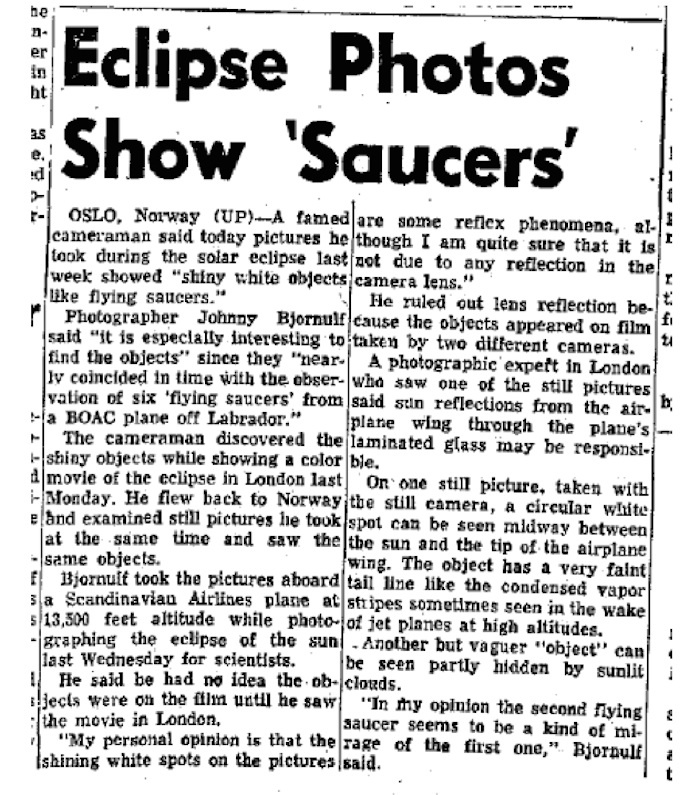
Flying Saucer Review tells a fascinating story
Flying Saucer Review of January-February, 1956 had a slightly different account than the media reports. In this story, which was
8
told by a Mr. Graham, indicated they had seen the objects during flight and Bjornulf then filmed them. This is probably the same
Graham quoted by NICAP. He stated that Bjornulf had been shooting through the open windows with no glass being present for reflection. The article also mentioned how skeptics looked foolish trying to explain the images. It seemed that the case was pretty solid.
Flying Saucer Review debunks the film
Sixteen years later, Flying Saucer Review published a new version of the story that said the film was a hoax!9 In that article Charles Bowen revealed that the film was not even taken by Bjornulf. It had actually been filmed by a man named Conradi. Apparently, Bjornulf began to promote the “saucer” aspect of the film a few days after the eclipse. At that point, a scientist in the eclipse party, Dr. Garwick, stated they were reflections in the window. In order to debunk the film, both Dr. Garwick and H.C. Christensen had a similar plane fly the same route at the same time of day. They noted similar reflections on the windows. Examination of the photographs taken during the eclipse and the position of the wing indicated that these were taken through the third window on the plane. Dr. Garwick explained:
The last two windows on the port side of the plane had been removed and everybody, including the photographer, were of the opinion that the pictures had been taken through window No. 2, i.e. through a window without panes so no reflections would appear.
The team (Brade, Garwick and Christensen - C.B.) took pictures out of the last three windows with the same camera which was used on the flight. These pictures were superimposed upon the pictures showing the light spots, and it was found that the wing perspective fitted exactly for the picture from the third (paned) window, and no others.10
If one looks closely at the photograph in Olmos’ image, one can clearly see a reflection in the window where the UFOs were located indicating that the image was taken through a window.11
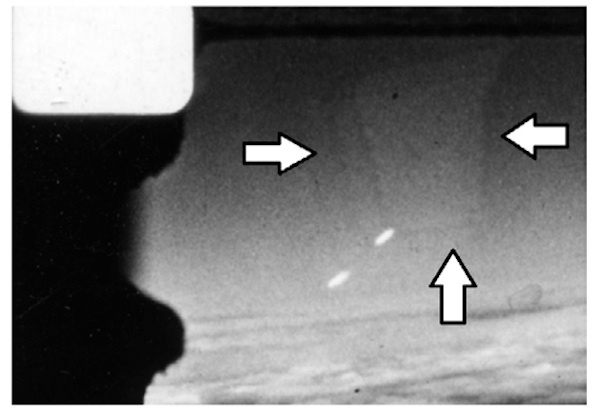
It appears this case had been debunked in 1954, when Brade, Garwick and Christensen had addressed the images in an article in Af- tenposten on October 14, 1954(see next page)!12 In that article, they presented their evidence as to which window the photographs were taken. Apparently, the proponents of the film were arguing that there was no window and had asked the photographer if he had taken them through a window or not. Conradi had replied he thought he had shot through one of the windows without glass but this was during totality. A photograph taken from the rear of the plane during the eclipse showed Conradi on the right side of the plane. This indicated that personnel were not always in the same location and, since the film was taken AFTER totality, it seems logical that Conradi had moved and filmed through a window with glass.13
For some reason, NICAP and Flying Saucer Review seemed to be unaware of this information when they published their one-sided account of what had transpired. It wasn’t until 1972, when somebody decided to look a bit further, was the true story revealed.
Case closed?
In 1991, Flying Saucer Review would publish another story about the film by somebody who was an advisor on films for the British Ministry of Supply. His story was based on his memories about seeing the film in the late 1950s. Some of the story did not quite
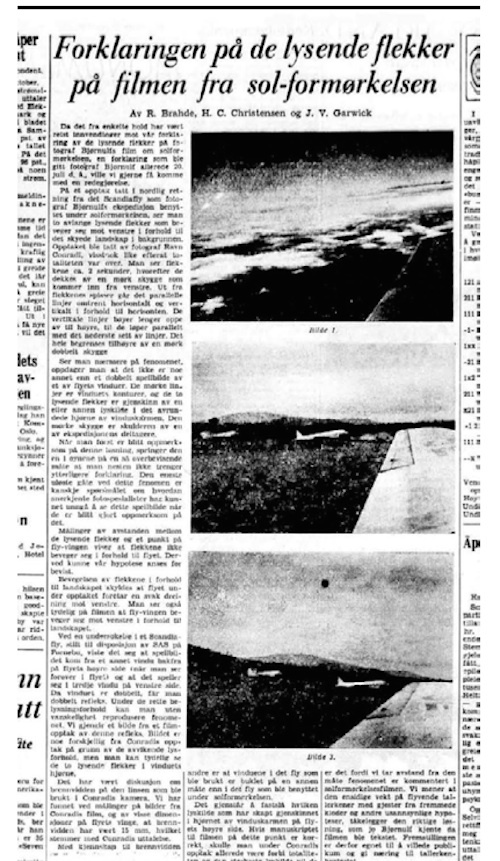
match with the story about the film. He seemed convinced that these UFOs were actual craft.14
That being said, the story told in the 1972 Flying Saucer review seems the most accurate. The sources are people who were present at the time the film was recorded and appear to be more reliable than those used by NICAP. In my opinion, the case should be considered explained and rejected as “UFO best evidence”.
Quelle: SUNlite 3/2017
